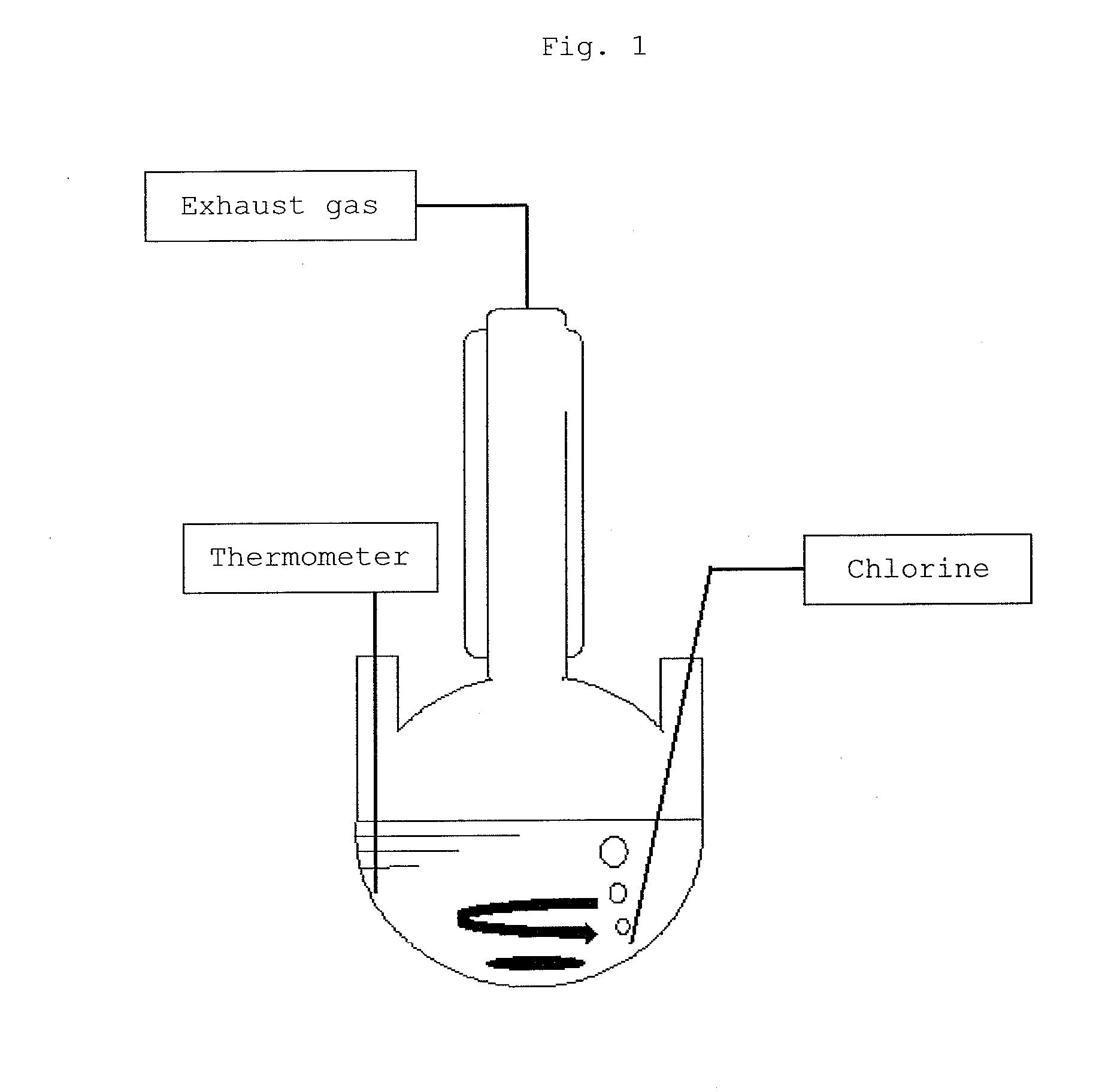Method for producing a chlorinated hydrocarbon having 3 carbon atoms
a chlorinated hydrocarbon and 3 carbon atom technology, applied in the field of chlorinated hydrocarbon production, can solve the problems of large amount of alkaline liquid waste produced after the reaction, large amount of alkaline liquid waste to be disposed, and the requirement of multiple reactors, etc., to achieve excellent reaction conversion and selectivity, and high selectivity
- Summary
- Abstract
- Description
- Claims
- Application Information
AI Technical Summary
Benefits of technology
Problems solved by technology
Method used
Image
Examples
example 1
[0105]182 g of purified 1,1,1,3-tetrachloropropane having a purity of 99.5 wt % and 0.10 g of anhydrous aluminum chloride (manufactured by Wako Pure Chemical Industries, Ltd.) were fed to a 200 mL four-necked eggplant flask. The resulting solution was stirred for 1 hour by setting its temperature to 20° C. The solution turned blue after 1 hour, by which it was confirmed that at least part of aluminum chloride was dissolved.
[0106]Thereafter, chlorine was supplied at a flow rate of 120 mL / min while the temperature of the solution was kept at 20° C. to start a reaction. After 4 hours, the supply of chlorine was stopped, and chlorine was removed by circulating nitrogen into the reaction solution.
[0107]When the reaction solution was analyzed by gas chromatography (GC), the conversion of 1,1,1,3-tetrachloropropane was 100%, and the selectivity of 1,1,1,2,3-pentachloropropane was 92% (yield of 92%).
example 7
[0112]182 g of 1,1,1,3-tetrachloropropane purified as described above and having a purity of 99.5 wt % and 0.10 g of anhydrous aluminum chloride were fed to a 200 mL four-necked eggplant flask. The temperature of the resulting solution was set to 20° C., and chlorine was supplied at a flow rate of 120 mL / min while the temperature of the solution was kept at 20° C. before the solution turned blue (that is, before anhydrous aluminum chloride was dissolved) to start a reaction. After 5 hours, the supply of chlorine was stopped, and nitrogen was circulated into the reaction solution to remove chlorine.
[0113]When the reaction solution was analyzed by gas chromatography (GC), the conversion of 1,1,1,3-tetrachloropropane was 100 and the selectivity of 1,1,1,2,3-pentachloropropane was 84% (yield of 84%).
TABLE 1Reaction conditions and resultsReaction conditionsCatalystChlorineReactionReactionAnalytical resultsAmountAt the startFlow ratetemperaturetimeConversionSelectivityYieldType(g)of suppl...
example 8
[0114]910 g of purified 1,1,1,3-tetrachloropropane having a purity of 99.5 wt % and 0.18 g of anhydrous aluminum chloride (manufactured by Wako Pure Chemical Industries, Ltd.) were fed to a 1,000 mL four-necked eggplant flask. The resulting solution was stirred for 1 hour by setting its temperature to 20° C. The solution turned blue after 1 hour, by which it was confirmed that at least part of aluminum chloride was dissolved. The concentration of 1,1,3-trichloropropene in the reaction solution at this point was about 1.0 wt %.
[0115]Thereafter, a reaction was carried out by changing the flow rate of chlorine in five stages as follows while the temperature of the solution was kept at 20° C.
[0116]First, chlorine was supplied at a flow rate of 500 mL / min for 20 minutes. The concentration of each component in the reaction solution after chlorine was supplied was as follows.[0117]1,1,3-trichloropropene: about 3 wt %[0118]1,1,1,3-tetrachloropropane: 90 wt %[0119]Chlorine: 0.17 wt %
[0120]Su...
PUM
| Property | Measurement | Unit |
|---|---|---|
| Temperature | aaaaa | aaaaa |
| Temperature | aaaaa | aaaaa |
| Temperature | aaaaa | aaaaa |
Abstract
Description
Claims
Application Information
 Login to View More
Login to View More - R&D
- Intellectual Property
- Life Sciences
- Materials
- Tech Scout
- Unparalleled Data Quality
- Higher Quality Content
- 60% Fewer Hallucinations
Browse by: Latest US Patents, China's latest patents, Technical Efficacy Thesaurus, Application Domain, Technology Topic, Popular Technical Reports.
© 2025 PatSnap. All rights reserved.Legal|Privacy policy|Modern Slavery Act Transparency Statement|Sitemap|About US| Contact US: help@patsnap.com

